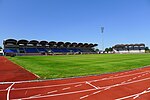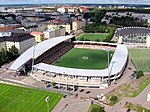Football in Finland
| Football in Finland | |
|---|---|
HJK Helsinki | |
| Country | Finland |
| Governing body | Football Association of Finland (Finnish: Suomen Palloliitto) |
| National team(s) | Men's national team Women's national team |
National competitions | |
Club competitions | |
League: Tier 1: Veikkausliiga, Kansallinen Liiga Tier 2: Ykkösliiga, Naisten Ykkönen Tier 3: Ykkönen, Naisten Kakkonen Tier 4: Kakkonen, Naisten Kolmonen Tier 5: Kolmonen, Naisten Nelonen Tier 6: Nelonen, Naisten Vitonen Tier 7: Vitonen Tier 8: Kutonen Tier 9: Seiska Cups: Finnish Cup Finnish Women's Cup | |
International competitions | |
Football in Finland is not, or at least has traditionally not been, the most popular spectator sport, which is in contrast to most European countries; it falls behind ice hockey, which enjoys a huge amount of popularity in the country.[1] Football tops ice hockey in the number of registered players (115,000 vs. 60,000[2][3]) and as a popular hobby (160,000 vs. 90,000 among adults and 230,000 vs. 105,000 among youths[4][5]). It is the most popular hobby among 3-18 year olds, whereas ice hockey is 9th.[5]
Football's standing is constantly increasing, especially among girls and women, where the yearly growth rate has lately been over 10 percent.
History

Football developed in Finland in the early twentieth century when Finland was still part of the
Domestic club competitions

The highest division in Finnish men's football is the Veikkausliiga, comprising 12 professional football teams. Below that is a league system maintained by the Finnish Football Association, with Ykkönen, or First Division, as the second highest division, with 10 teams. Beneath Ykkönen, each division is divided into 'groups' based on the location of the clubs. For instance, the Second Division, or Kakkonen, has 40 teams divided into four regional groups, each of 10 teams.
The Finnish Cup is Finland's national cup competition, open to all member clubs of the Finnish Football Association. In the 2009 season, 356 clubs signed up to take part in the competition.[7]
All Finnish domestic football competitions take place in the spring, summer and autumn, due to weather conditions. Similar systems are used in the other Nordic countries as well, except for Denmark which had that system in the past.
National team
The
The Football Association of Finland also organizes national under-19 and under-21 teams.
The
Åland Islands
Since 1943 the
Football stadiums in Finland
Stadiums with a capacity of 10,000 or higher are included.
| # | Photo | Stadium | Capacity | City | Home Team | Founding year | Cite |
|---|---|---|---|---|---|---|---|
| 1 | 
|
Helsinki Olympic Stadium | 36,200 | Helsinki | Finland | 1938 | [9] |
| 2 | 
|
Tampere Stadium
(Ratina Stadion) |
16,800 | Tampere | Finland, Ilves |
1966 | [10] |
| 3 | 
|
Lahden Stadion |
14,465 | Lahti | FC Lahti | 1981 | [11] |
| 4 | 
|
Paavo Nurmi Stadium | 13,000 | Turku | 1893 | [12] | |
| 5 | 
|
Porin Stadion |
12,300 | Pori | FC Jazz | 1966 | [13] |
| 6 | 
|
Bolt Arena | 10,770 | Helsinki | HIFK,
Finland |
2000 | [14] |
References
- ^ "Lajeja paikan päällä vähintään kerran vuodessa seuraavien määrä lajeittain 19-65-vuotiaiden keskuudessa" (PDF). Kansallinen liikuntatutkimus 2005-2006. Ministry of Education. 2006. Retrieved 13 February 2010.[permanent dead link]
- ^ a b "Suomen Palloliitto". Football Association of Finland. Archived from the original on 23 April 2011. Retrieved 13 February 2010.
- ^ "Info". Finnish Ice Hockey Association. Archived from the original on 27 February 2010. Retrieved 13 February 2010.
- ^ a b "Urheilulajien harrastajamäärät 19-65-vuotiaiden keskuudessa" (PDF). Kansallinen liikuntatutkimus 2005-2006. Ministry of Education. 2006. Retrieved 13 February 2010.[permanent dead link]
- ^ a b c "Urheilulajien harrastajamäärät 8-13-vuotiaiden keskuudessa" (PDF). Kansallinen liikuntatutkimus 2005-2006. Ministry of Education. 2006. Retrieved 13 February 2010.[permanent dead link]
- ^ a b "Jalkapallo kasvussa Suomessa ja maailmalla". refers to FIFA Big Count 2006. Football Association of Finland. 2007-06-19. Archived from the original on 20 July 2011. Retrieved 13 February 2010.
- ^ "Participants". Finnish Cup 2009. Football Association of Finland. 2009. Archived from the original on April 8, 2009. Retrieved 13 February 2010.
- ^ a b "Archived copy". Archived from the original on 2014-06-07. Retrieved 2014-06-04.
{{cite web}}: CS1 maint: archived copy as title (link) - ^ "Stadium Facts | Olympiastadion". www.stadion.fi. Retrieved 2023-10-02.
- ^ "Tampere Stadium | www.tampere.fi". www.tampere.fi. Retrieved 2023-10-02.
- ^ "Lahden stadion – StadiumDB.com". stadiumdb.com. Retrieved 2023-10-22.
- ^ "Paavo Nurmen stadion – Nokiamissio.com" (in Finnish). 2019-02-17. Retrieved 2023-10-22.
- ^ "Stadion". Porin kaupunki (in Finnish). Retrieved 2023-10-22.
- ^ "Coming to a match? Information for match event! - HJK Helsinki - Bolt Arena". HJK Helsinki. Retrieved 2023-10-22.
External links
- Football Association of Finland
- Finnish football blog
- Escape To Suomi
- League321.com - Finnish football league tables, records & statistics database. (in English)
- flashscore - Football Finnish league - Finland Live Scores, Results.(in English)
